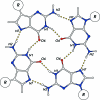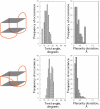Classification of g-quadruplex DNA on the basis of the quadruplex twist angle and planarity of g-quartets
- PMID: 22649667
- PMCID: PMC3347588
Classification of g-quadruplex DNA on the basis of the quadruplex twist angle and planarity of g-quartets
Abstract
The present work is devoted to the analysis of the G-quadruplex DNA structure using the bioinformatics method. The interest towards quadruplex DNAs is determined by their involvement in the functioning of telomeres and onco-promoters as well as by the possibility to create on their basis aptamers and nanostructures. Here, we present an algorithm for a general analysis of the polymorphism of the G-quadruplex structure from the data bank PDB using original parameters. 74 structures were grouped according to the following parameters: the number of DNA strands, the number of G-quartets, and the location and orientation of the connecting loops. Two quantitative parameters were used to describe the quadruplex structure: the twist angle between two adjacent quartets (analogous to that for the complementary pair in the duplex DNA) and the quartet planarity (an original parameter). The distribution patterns of these values are specific for each group of quadruplex structures and are dependent upon the type of connecting loops used (diagonal, lateral or propeller). The tetramolecular loopless parallel quadruplex was used as a comparison template. The lateral loops introduce the strongest distortion into the structure of quadruplexes: the values of the twist angles are the lowest and are not typical for the other quadruplex groups. The loops of the diagonal type introduce much weaker deformation into quadruplexes; the structures with propeller loops are characterized by the optimum geometry of G-quartets. Hence, the correlation between the twist angle and the tension in the structure of quadruplex DNA is revealed.
Keywords: G-quadruplex; G-quartet; loops; structure; twist angle.
Figures










References
LinkOut - more resources
Full Text Sources
